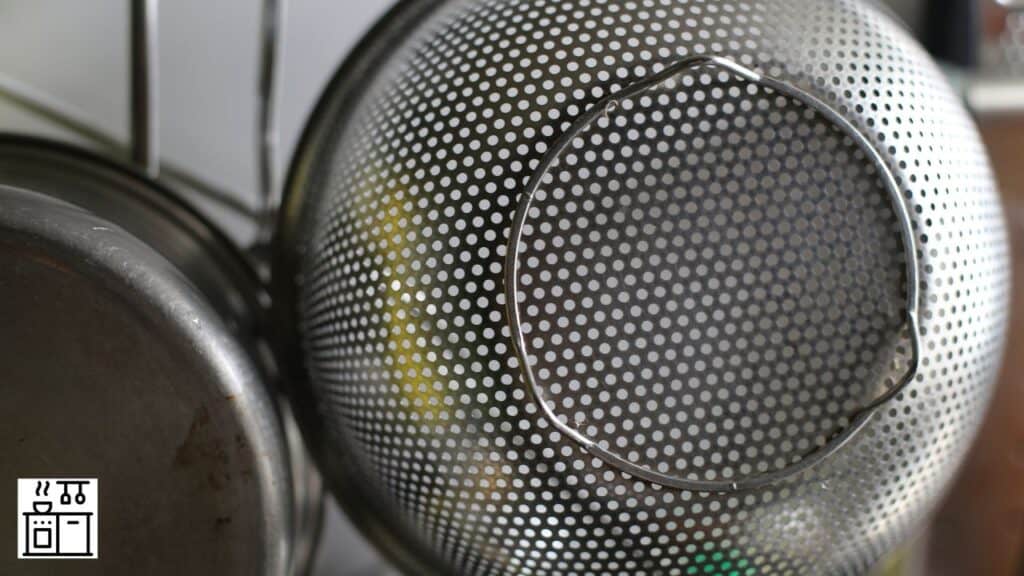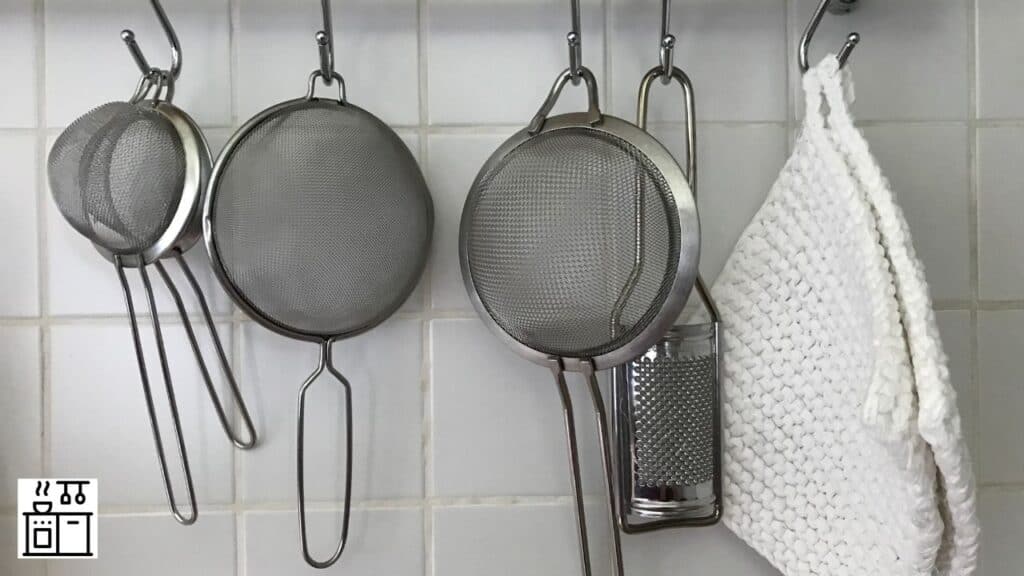Dishwashers can clean almost any utensil in your kitchen—again, almost. With that in mind, are strainers dishwasher-safe?
Most strainers are dishwasher-safe, depending on the material of the strainer and how well it can withstand dishwasher heat. However, the finely detailed netting of the strainer can catch food bits from other dirty dishes in the dishwasher. This makes dishwasher cleaning inconvenient for strainers.
Stick around to get a better idea of why the use of a dishwasher may not be the best cleaning technique for strainers, even though they can be dishwasher-safe. We’ll also discuss how you should clean strainers instead.
- Why Shouldn't You Put Strainers In The Dishwasher?
- Are Plastic Strainers Dishwasher-Safe?
- Are Mesh Strainers Dishwasher-Safe?
- Are Silicone Strainers Dishwasher-Safe?
- Can You Put A Metal Strainer In The Dishwasher?
- How To Properly Clean Strainers?
- Tips To Clean Your Strainer
- Which Dishwasher-Safe Strainers Can You Use?
Why Shouldn’t You Put Strainers In The Dishwasher?
Think about it; what do you use strainers for?
Whether it’s for cleaning fruits and vegetables or even for your pasta, they can get pretty dirty.
A simple rinse might not be enough to clean your strainer properly even after one use.
You might simply give up and chuck it in the dishwasher, but we have to stop you there.
Even though dishwashers are a wonderful addition to your kitchen, they might not be the best method to wash each tiny hole in a strainer.
Fragments of your leftovers can still get stuck in there.
The hard-to-reach areas might not receive the deep cleaning you were hoping for.
If you clean a strainer in the dishwasher, you might still notice starchy residue from your last cooking session.
Keep in mind that you might also face issues with plated strainers since they could chip away and cause further damage to your dishwasher.
Are Plastic Strainers Dishwasher-Safe?
One of the most crucial dishwasher precautions you should keep in mind is the extreme heat your kitchen tools will be exposed to during the cleaning process.
You should make sure that these tools can withstand this much heat. Temperatures can run as high as 140°F.
Having said that, most plastic kitchenware shouldn’t be mingling in there.
Plastic strainers are no different. They can succumb to the high heat in a dishwasher and melt.
You might risk ruining the netting of your strainer as well.
Nevertheless, some strainers are composed of heavy-duty plastic that can easily hold out against high temperatures.
The bad news is that even if it can take the heat, it still won’t be washed out properly.
You might still notice pieces of food stuck in the strainer’s pesky holes.
Recommended Further Reading: What Can You Use Strainers For? | Do You Need To Season Cast Iron Skillets? | Anodized Pans Have Teflon? | Do Dutch Ovens Cook Faster?
Are Mesh Strainers Dishwasher-Safe?
We recommend leaving your mesh strainer out of the dishwasher.
Not only will it provide a poor wash, but it can also ruin your dishwasher’s rack.
The strainer’s jagged edges can easily scrape and cut through your dishwasher rack’s plastic layer and uncover the second metal layer.
Metal is notoriously damaging for the dishwasher as well.
Are Silicone Strainers Dishwasher-Safe?
If you don’t like the thought of cleaning your strainer manually, then you might want to consider silicone strainers.
Those are some of the safest strainers you can put in your dishwasher.
If you have a high-quality silicone strainer, that’s even better. You wouldn’t have to worry about it warping or deforming.
Can You Put A Metal Strainer In The Dishwasher?

It all depends on what kind of metal the strainer is composed of.
Stainless steel is your safest bet for the dishwasher. On the other hand, you should try to avoid copper and aluminum.
Those will just rust, become dull, and render them unusable.
How To Properly Clean Strainers?
We said that some strainers are dishwasher-safe while others aren’t, but that’s not the bigger picture here.
The bigger picture is that using a dishwasher to clean your strainer won’t be sufficient.
That’s why we’ve included a guide on how you can give it a good wash. Check it out below.
Step 1: Prepare Your Cleaning Tools
In this step, you want to have your cleaning tools on hand.
You’re going to need a scrub brush, sponge, dish soap, vinegar, a bowl, and of course, some elbow grease.
Step 2: Soak The Strainer
Now that your items are ready get your bowl and fill it up with hot water, vinegar, and dish soap.
Make sure to keep your whole strainer submerged in the water to get the best clean.
Try to soak the strainer for at least 15 minutes.
You should bear in mind that some strainers might be sensitive to hot water such as plastic.
In this case, you can try to move the handle out of the water while the rest of the mesh is submerged.
If the mesh on your strainer is also made of plastic, then it’s best just to skip this step altogether and move on to scrubbing.
Step 3: Scrub The Strainer
With your finest cleaning brush, grab the soaked strainer and go to town.
You need to make sure you cover both inside and outside the strainer.
Alternatively, you can use a rough sponge to get all the leftover food out of each hole.
Step 4: Dry The Strainer
The best way to dry your trainer is the good ol’ air-drying method.
Leave it out to sit for as long as it takes on a clean kitchen towel or dish rack.
Tips To Clean Your Strainer
There are a few ways to make your life easier when trying to clean your strainer. Check out our tips below.
- Don’t use a towel to dry your strainer. You might risk harmful bacteria harboring in the tiny fine holes, leading to fungus. Not very appetizing.
- Use a bottle cleaner brush if some stubborn areas need extra handling.
- Right after you’re done using the strainer, always give it a proper rinse and clean before it dries out. The more you leave it with the food particles stuck inside, the harder it will be to remove them.
- Make use of the sprayer in your sink to take advantage of the high water pressure that can prove effective at detaching the bits stuck in there. Be sure to use the sprayer on the convex side of the strainer.
- Don’t be afraid to use other sharp tools to floss out your strainers, such as a toothpick or pipe cleaner.
Interesting Further Reading: Will Ceramic Pans Stick? | Will Stainless Steel Pans Discolor? | Do Professional Chefs Use Pressure Cookers? | Are Strainers And Sifters The Same?
Which Dishwasher-Safe Strainers Can You Use?
If you’re looking for the best dishwasher-safe strainers and want to avoid all the scrubbing, some strainers can make things much easier.
We recommend looking for strainers on the larger side and having slightly bigger holes.
Luckily, there are numerous variations of them in the market.
One of the best for making pasta is the side-clip strainer.
It’ll be much more convenient to use and clean since there’s less surface area to cover.
They’re also usually made out of silicone which is ideal for dishwasher use.
Another option could be a sink strainer.
Those are also relatively less fussy to clean out and provide you with abundant applications.
Since they’re made of stainless steel, you can pop them in your dishwasher.

